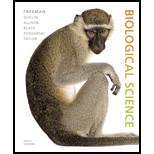
Concept explainers
Which of the following occurs when a covalent bond forms?
a. Electrons in valence shells are transferred from one atom to another.
b. Electrons in valence shells are shared between atoms.
c. Partial charges on polar molecules interact.
d. Nonpolar molecules are pushed together by surrounding water molecules.
Introduction:
Covalent bonds are formed by sharing of the electron pairs between atoms. These electron pairs are referred to as shared pairs or bonding pairs. The chemical bond in which the complete transfer of electron present in the outer shell takes place is known as an ionic bond.
Answer to Problem 1TYK
Correct answer:
Electrons in valence shells are shared between atoms.
Explanation of Solution
Explanation/Justification for the correct answer:
Option (b) is given that the bond is formed by the electron sharing. Covalent bonding occurs when pairs of electrons are shared between atoms. Atoms are covalently bond with other atoms by forming a full electron shell providing more stability. By sharing their outer most (valence) electrons, atoms can fill up their outer electron shell and gain stability. Hence, option (b) is correct.
Explanation for incorrect answers:
Option (a) is given that the valence shells are transferred. The chemical bond, in which the complete transfer of electron present in the outer shell occurs is known as an ionic bond. So, it is incorrect answer.
Option (c) The polar molecules have partial charges present on them, the interaction of the two-partial charged atoms results in the formation of the dipole-dipole interaction. It takes place when two molecules carry opposite partial charge. So, it is incorrect answer.
Option (d) The interaction between the water and the non-polar molecule, in which the non-polar molecules attract themselves is known as hydrophobic interaction. These molecules do not form bonding with the water molecules, as a result, they are forced to interact among themselves. So, it is incorrect answer.
Hence, options (a), (c) and (d) are incorrect.
Covalent bonds are formed when electrons are shared between atoms.
Want to see more full solutions like this?
Chapter 2 Solutions
Biological Science (6th Edition)
- This occurs when the cations and anions are attracted to the positive and negative ends of water molecules: A. ionic bonding B. dissociation C. covalent bonding D. hydrogen bondingarrow_forwardWhich of the following statements is true? a. Acids and bases cannot mix together. b. Acids and bases will neutralize each other. c. Acids, but not bases, can change the pH of a solution. d. Acids donate hydroxide ions (OH–); bases donate hydrogen ions (H+).arrow_forwardThe type of bonding that happens between atoms within a water molecule is which of the following? a. Polar covalent bonding b.ionic bonding c. Non polar covalent bonding d. Hydrogen bondingarrow_forward
- Which of the following statements best explains the insolubility of lipids in water? a. The structure of lipids includes hydrophilic molecules. b. The polar portion of lipids is much larger than the nonpolar portion. c. The polar portion of lipids is much smaller than the nonpolar portion. d. The polar and nonpolar portions of lipids are of the same size.arrow_forwardWhich of the following bonding types is the most important in the nonaqueous interfaces between protein subunits? a. van der Waals interactions b. the hydrophobic effect c. ionic bonds d. disulfide bridgesarrow_forwardWhich of the following describes the interaction between the amino acid last eluted and the anion exchanger at pH 7? a. dipole-dipole b. hydrophobic c. ionic d. H-bondingarrow_forward
- These are the weakest bonds of all and are sensitive to pH as well as changes in temperature. a. nonpolar covalent bonds b. polar covalent bonds c. ionic bonds hydrogen bondsarrow_forwardWater molecules have one oxygen atom that is more electronegative than the two hydrogen atoms bound to it. As a result, which type of bonding hold water molecules together a. non-popular covalent bonding b. polar covalent bonding c.ionic bonding d.hydriohocicarrow_forwardA carbon atom contains six protons and six neutrons.A. What are its atomic number and atomic weight?B. How many electrons does it have?C. How many additional electrons must it add to fill its outermost shell? How does this affect carbon’s chemical behavior?D. Carbon with an atomic weight of 14 is radioactive. How does it differ in structure from nonradioactive carbon? How does this difference affect its chemical behavior?arrow_forward
- This type of noncovalent bond is responsible for clustering fatty acid tails of phospholipids in a micelle. a. Disulfide bonds b. Hydrogen bonds c. Hydrophobic interactions d. Ionic interactions e. van der Waals interactionsarrow_forwardWhich of the following substances will dissolve in water A.nonpolar B.polar C.hydrophobic D.hydrophilic E.ionicarrow_forwardThe ability of non-polar substances like fat molecules to clump together in water thereby allowing minimal contact between the fat molecules and water is attributed to: Group of answer choices a. Hydrogen bonds b. Ionic bonds c. Van der Waal’s interactions d. Hydrophobic interactions e. Cystine bridgesarrow_forward
 Human Anatomy & Physiology (11th Edition)BiologyISBN:9780134580999Author:Elaine N. Marieb, Katja N. HoehnPublisher:PEARSON
Human Anatomy & Physiology (11th Edition)BiologyISBN:9780134580999Author:Elaine N. Marieb, Katja N. HoehnPublisher:PEARSON Biology 2eBiologyISBN:9781947172517Author:Matthew Douglas, Jung Choi, Mary Ann ClarkPublisher:OpenStax
Biology 2eBiologyISBN:9781947172517Author:Matthew Douglas, Jung Choi, Mary Ann ClarkPublisher:OpenStax Anatomy & PhysiologyBiologyISBN:9781259398629Author:McKinley, Michael P., O'loughlin, Valerie Dean, Bidle, Theresa StouterPublisher:Mcgraw Hill Education,
Anatomy & PhysiologyBiologyISBN:9781259398629Author:McKinley, Michael P., O'loughlin, Valerie Dean, Bidle, Theresa StouterPublisher:Mcgraw Hill Education, Molecular Biology of the Cell (Sixth Edition)BiologyISBN:9780815344322Author:Bruce Alberts, Alexander D. Johnson, Julian Lewis, David Morgan, Martin Raff, Keith Roberts, Peter WalterPublisher:W. W. Norton & Company
Molecular Biology of the Cell (Sixth Edition)BiologyISBN:9780815344322Author:Bruce Alberts, Alexander D. Johnson, Julian Lewis, David Morgan, Martin Raff, Keith Roberts, Peter WalterPublisher:W. W. Norton & Company Laboratory Manual For Human Anatomy & PhysiologyBiologyISBN:9781260159363Author:Martin, Terry R., Prentice-craver, CynthiaPublisher:McGraw-Hill Publishing Co.
Laboratory Manual For Human Anatomy & PhysiologyBiologyISBN:9781260159363Author:Martin, Terry R., Prentice-craver, CynthiaPublisher:McGraw-Hill Publishing Co. Inquiry Into Life (16th Edition)BiologyISBN:9781260231700Author:Sylvia S. Mader, Michael WindelspechtPublisher:McGraw Hill Education
Inquiry Into Life (16th Edition)BiologyISBN:9781260231700Author:Sylvia S. Mader, Michael WindelspechtPublisher:McGraw Hill Education





